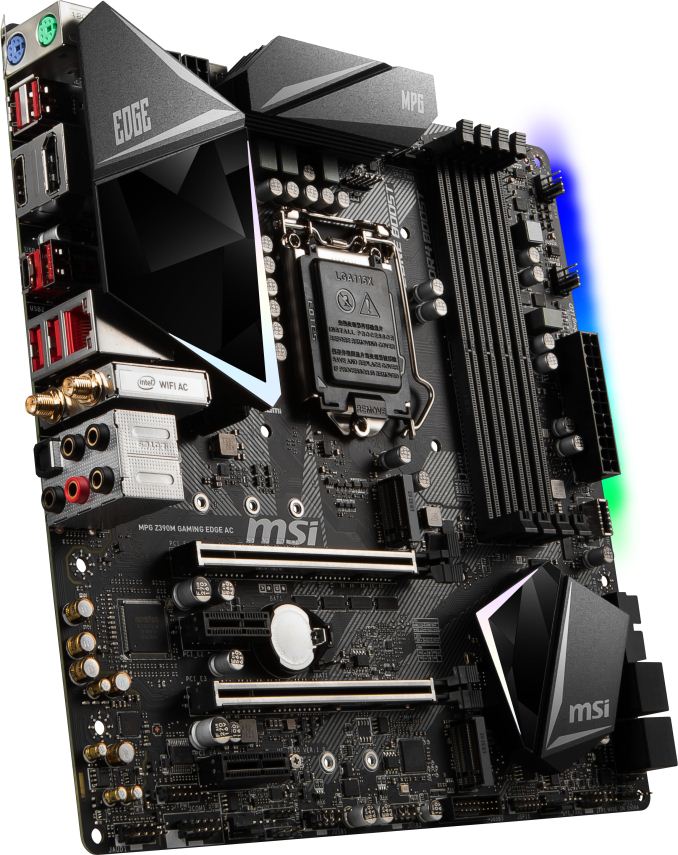Intel Z390 Motherboard Overview: 50+ Motherboards Analyzed
by Ian Cutress & Gavin Bonshor on October 8, 2018 10:53 AM EST- Posted in
- Motherboards
- Intel
- MSI
- Gigabyte
- ASRock
- EVGA
- Asus
- NZXT
- Supermicro
- Z390
MSI MPG Z390M Gaming Edge AC
The MSI MPG Z390M Gaming Edge AC is the smaller sibling to the ATX sized Gaming Edge AC model (mATX) and as a result, a smaller PCB means less slot space available. Like the bigger sized model, the main feature of the Gaming Edge AC range is Wi-Fi connectivity and this is provided by an Intel 9560 802.11ac 2T2R Wi-Fi adapter which is surprisingly higher spec than the one integrated (Intel 9462) onto the ATX variant.
In terms of PCIe support, the MPG Z390M Gaming Edge AC has a total of two full-length PCIe 3.0 slots with the top slot having x16 bandwidth available and the second slot only having x8. This allows users to use both two-way SLI and CrossFire multi-GPU configurations. Also included on the board are two PCIe 3.0 x1 slots. Memory capability consists of four slots with up to DDR4-4500 and a maximum capacity of 64 GB. The board has two PCIe/SATA support M.2 slots present and has a total of four SATA ports; a direct consequence of the mATX form factor.
Just like the bigger ATX sized Gaming Edge AC model, this model benefits from a Realtek ALC1220 HD audio codec and Intel I219V Gigabit networking controller which handles the 8-channel audio and single LAN port on the rear panel respectively. In terms of USB, the rear panel contains a total of two USB 3.1 Gen2 (Type-A and Type-C) and four USB 3.0 Type-A ports. Users looking to use more devices can do so using the internal headers which offer a further four USB 3.0 and four USB 2.0 ports. The Z390M Gaming Edge AC is also suitable for users looking to make use of the 8th and 9th generation Intel processors with integrated iGPUs thanks to a pair of video outputs which consists of an HDMI and DisplayPort.
The MSI MPG Z390M has a suggest launch price of $180 and is primarily aimed at gamers looking to build a system with a smaller overall footprint of an ATX system. The inclusion of a 2T2R 802.11ac Wi-Fi adapter and Realtek ALC1220 HD audio codec means MSI has focused on providing higher-end features to their more mid-ranged offerings.












79 Comments
View All Comments
Smell This - Tuesday, October 9, 2018 - link
Much.Of.
The.
Same.
2 HSIO lanes per Gen 2 port and WiFi. Wow (rolling I-eyeballs) ...
MadAd - Tuesday, October 9, 2018 - link
58 motherboards, only 13 of which are smaller than ATX. When on earth are we going to move off this outdated oversized format? Its just more of the same every time, so depressing.gavbon - Wednesday, October 10, 2018 - link
13 is better than 0, or 12 :DMadAd - Wednesday, October 10, 2018 - link
Considering very small form formats (ITX) are harder to build for and only 7 are uATX, a size which is the most useful to transition away from ATX then no, it feels like an afterthought from a lazy industry. I mean who uses more than 1 main video card and 2-4 sticks of ram in a gaming PC these days? Even water builds into uATX isnt that hard to accomplish.After literally decades ATX should be a choice for edge cases not a mainstream build.
shaolin95 - Monday, October 22, 2018 - link
who cares about midge boards!Edkiefer - Wednesday, October 10, 2018 - link
All these MB with 2x 8 pin power inputs, is both mandatory and if so I guess new PSU will need 2x 8pin now.entity279 - Wednesday, October 10, 2018 - link
so it's ok to just buy SM motherboards now with them being involved in a security scandal?gavbon - Thursday, October 11, 2018 - link
I currently have the Supermicro C9Z390-PGW awaiting to go on the test bench next week, so from a consumers standpoint, I could potentially shed light on that board. As far as the Chinese/Supermicro/Spy scandal goes, I don't want to speculate without the finer details.eastcoast_pete - Wednesday, October 10, 2018 - link
Ian & Gavin, thanks for the overview.@ both - Question: I've read that Intel, to deal with its bad planning/capacity problems on 14 nm, has contracted the fabbing of some of its chipsets out to TSMC, specifically in TSMC's 22 nm tech. Is that correct, and did you have a chance to confirm that the new 390s used by these boards are indeed made by Intel on their 14 nm FinFET tech, or are they made by a contractor (TSMC)?
DanNeely - Wednesday, October 10, 2018 - link
AFAIK the chipsets being reverted to 22nm are using Intel's 22nm process in old unupgraded fabs. Doing so would be far less work than porting to a process from a different company; the latter would require massive rework to follow a completely different set of design rules.